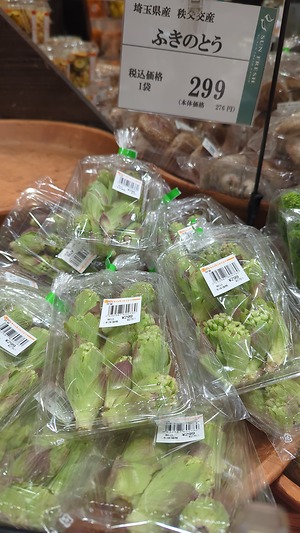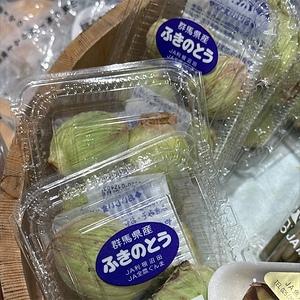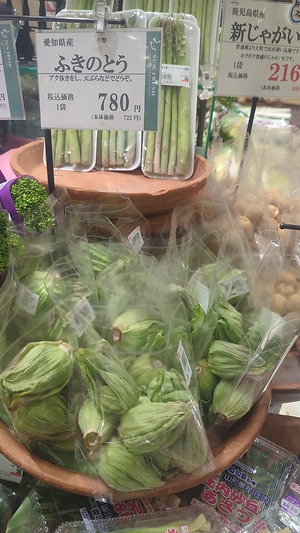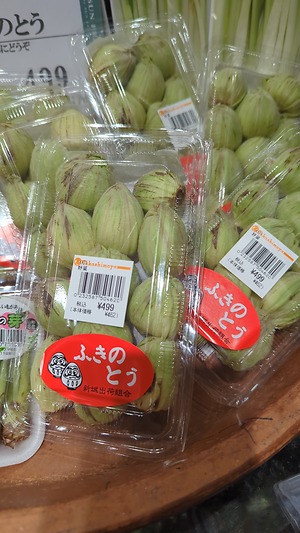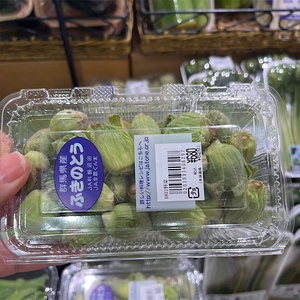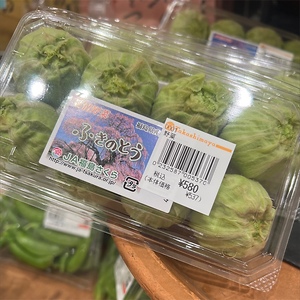


Butterbur Sprout
Estimated Inventory, lb : 0
Description/Taste
Butterbur sprouts are small and tightly clustered, immature flower buds, averaging 5 to 6 centimeters in diameter, and are encased in a thin sheath of smooth, light green leaves. The sprouts are harvested when the outer leaves are still closed, and when the leaves are peeled back, they reveal a globular, compact cluster of pale green buds. The tiny flower buds are generally closed and firm, and at the base of the buds is a thick, purple stalk. Butterbur sprouts, when cooked, have a crisp and tender consistency with an earthy, vegetal, and bitter flavor.
Seasons/Availability
Butterbur sprouts are available in the winter through early spring.
Current Facts
Butterbur sprouts, botanically classified as Petasites japonicus, are young flower buds of a leafy, herbaceous perennial that belongs to the Asteraceae family. In Japan, the sprouts are also known as Fukinoto, and the pale green clusters emerge at the end of winter, often appearing through blankets of snow. Butterbur sprouts are a symbol of the coming spring in Japan. The sprouts are one of the first greens to surface in the forests and are known as a sansei vegetable, which translates from Japanese to mean “mountain vegetable.” Sansai vegetables are traditionally harvested by hand and are highly regarded as specialty ingredients. Butterbur sprouts are favored for their bitter taste, which is believed to have detoxifying effects, and the buds are prepared simply in dishes to showcase their pungent flavor, leading many locals to claim the buds as the “fresh taste of spring.”
Nutritional Value
Butterbur sprouts are an excellent source of fiber, which can help regulate the digestive tract, and provide beta-carotene, vitamins B1, B2, B3, and C, calcium, and potassium. The buds also contain fukinolic acid and chlorogenic acid, which are believed to promote anti-allergy and anti-inflammatory benefits.
Applications
Butterbur sprouts must be boiled before consumption as the bitter flavor when raw is often considered unpalatable. The traditional preparation method for this vegetable involves a technique known as aku-nuki, meaning "harshness removal." This is done through various methods in Japan, but parboiling the flower buds in salted water for several minutes is the most popular technique, rinsing and finishing in an ice bath. After the pre-treatment, the sprouts can be added to soups such as udon, buckwheat, and miso or boiled as ohitashi, which is a cooked vegetable served in a dashi-based sauce. Butterbur sprouts are also frequently battered and fried into tempura. Frying is believed to help counterbalance the bitter flavors and help retain the earthy taste of the buds. In addition to serving as a stand-alone dish, Butterbur sprouts can be finely minced and stirred into miso to make a relish known as fukinotou-miso. This miso is commonly served over rice, used as a vegetable dip, or is mixed with chicken, tofu, or fish. The immature buds should be consumed immediately for the best quality and flavor, but they can be loosely wrapped in a bag and stored in the refrigerator for up to one week. The buds can also be parboiled and frozen for 3 to 6 months.
Ethnic/Cultural Info
In Japan, sansei vegetables such as Butterbur sprouts have been used for medicinal purposes for centuries and are revered for their high nutritional properties. The entire plant, including the root, stalks, and leaves, are used as remedies for coughs, excessive mucus, pollen allergies, and to help improve digestion. Butterbur sprouts are also used as a natural herbal remedy for asthma, whooping cough, fever, and spasms. Beyond foraging the buds for medicinal uses, Butterbur sprouts evoke strong memories of spring, and many Japanese families spend winter days together gathering the green sprouts. Foraging techniques are traditionally passed on between generations, and the wild harvesting is done carefully to preserve and encourage continued growth year after year, leaving both male and female flowers to reproduce.
Geography/History
Butterbur sprouts are native to Southeast Asia, including China, Korea, and Japan, and have been growing wild since ancient times. In Japan, the sprouts have been commercially cultivated since the Heian period, which lasted from 794 to 1185 CE, and grow in wet winter soils of the mountainous regions of Hokkaido, Honshu, Shikoku, Kyushu, and Okinawa. The sprouts are also grown in greenhouses in Gunma, Fukushima, and Hokkaido for commercial sale. Butterbur sprouts can be gathered from the wild, sold at fresh local markets, and grown in home gardens. Outside of Asia, the sprouts can sometimes be found growing in home gardens in North America and Europe, which were first introduced by Japanese immigrants.
Recipe Ideas
Recipes that include Butterbur Sprout. One
| Hokuriku Expat Kitchen |
|
Fukinotou Miso Paste |
| Star Chefs |
|
Landscape of February Satoyama |



